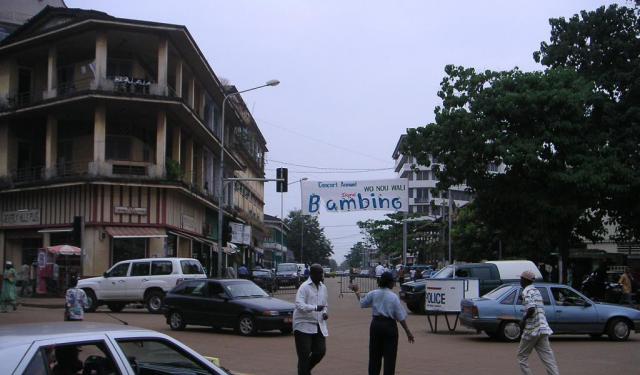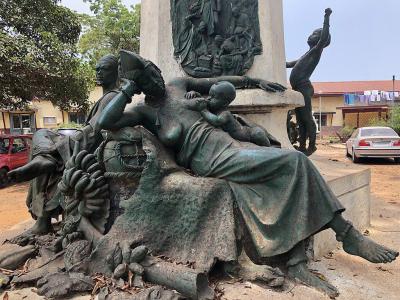
Conakry Ile Tombo Tour (Self Guided), Conakry
Tombo Island is where the old colonial city of Conakry is located. Connected to the Kaloum Peninsula, this part of the city is where you will find the Autonomous Port of Conakry and Port Boulbinet. Many government offices, embassies and international missions are located here as well. Take the following tour to discover some of Conakry’s best attractions.
How it works: Download the app "GPSmyCity: Walks in 1K+ Cities" from Apple App Store or Google Play Store to your mobile phone or tablet. The app turns your mobile device into a personal tour guide and its built-in GPS navigation functions guide you from one tour stop to next. The app works offline, so no data plan is needed when traveling abroad.
Conakry Ile Tombo Tour Map






Guide Name: Conakry Ile Tombo Tour
Guide Location: Guinea » Conakry (See other walking tours in Conakry)
Guide Type: Self-guided Walking Tour (Sightseeing)
# of Attractions: 7
Tour Duration: 2 Hour(s)
Travel Distance: 4.1 Km or 2.5 Miles
Author: AlexanderA
Sight(s) Featured in This Guide:
Guide Location: Guinea » Conakry (See other walking tours in Conakry)
Guide Type: Self-guided Walking Tour (Sightseeing)
# of Attractions: 7
Tour Duration: 2 Hour(s)
Travel Distance: 4.1 Km or 2.5 Miles
Author: AlexanderA
Sight(s) Featured in This Guide:
- Musee National de Guinee (National Museum of Guinea)
- Palais Mohammed V (Mohammed V Palace)
- Cathedrale Sainte-Marie de Conakry (Cathedral of Saint Mary)
- Port Autonome de Conakry (Autonomous Port of Conakry)
- Direction Nationale des Douanes (National Customs Department)
- Marche du Niger (Niger Market)
- Archeveche de Conakry (Archdiocese of Conakry)
1) Musee National de Guinee (National Museum of Guinea) (must see)
National Museum of Guinea was established shortly after independence in 1960. It contains displays of the ethnography and prehistory of Guinea, and has a considerable collection of masks and fetishes and a range of art. The museum is located beside the Ignace Deen Hospital.
Sight description based on Wikipedia.
2) Palais Mohammed V (Mohammed V Palace)
The Mohammed V Palace, originally known as the Palais des Nations, serves as a significant public building with a storied history. Constructed to serve as the headquarters for the Organization of African Unity, its role has evolved considerably over the years. The building suffered extensive damage in 1996 due to a bombing incident during a mutiny by the Guinean army, leading to a long period of abandonment.
After being left derelict for nearly 15 years, it underwent a major renovation to prepare for the 40th summit of the Organization of Islamic Cooperation's foreign ministers in December 2013. The renaming of the palace was a symbolic gesture by Professor Alpha Condé in 2014, coinciding with an official visit from King Mohammed VI of Morocco. Following the 2021 Coup d'Etat in Guinea, the palace has become the seat of power for Mamadi Doumbouya, marking a new chapter in its historical significance.
After being left derelict for nearly 15 years, it underwent a major renovation to prepare for the 40th summit of the Organization of Islamic Cooperation's foreign ministers in December 2013. The renaming of the palace was a symbolic gesture by Professor Alpha Condé in 2014, coinciding with an official visit from King Mohammed VI of Morocco. Following the 2021 Coup d'Etat in Guinea, the palace has become the seat of power for Mamadi Doumbouya, marking a new chapter in its historical significance.
3) Cathedrale Sainte-Marie de Conakry (Cathedral of Saint Mary) (must see)
The Cathedral of Saint Mary is an important place of Christian worship in Conakry. The yellow and red building is of considerable architectural interest. Monseigneur Raymond René Lérouge laid the foundation stone of the Cathedral in 1928. The Cathedral was built in the 1930s, and has impressive architecture, with Orthodox design elements. The Palais Presidentiel is behind the cathedral. Opposite is the Ministry of Higher Education and Scientific Research.
The cathedral is the primary place of worship for the Roman Catholic Archdiocese of Conakry, established on 18 October 1897 as the Apostolic Prefecture of French Guinea, and promoted to its present rank on 14 September 1959. From May 2003 the Archbishop was Vincent Coulibaly. Since the people of Guinea are mainly Muslim, the cathedral does not have a large congregation.
The cathedral is the primary place of worship for the Roman Catholic Archdiocese of Conakry, established on 18 October 1897 as the Apostolic Prefecture of French Guinea, and promoted to its present rank on 14 September 1959. From May 2003 the Archbishop was Vincent Coulibaly. Since the people of Guinea are mainly Muslim, the cathedral does not have a large congregation.
Sight description based on Wikipedia.
4) Port Autonome de Conakry (Autonomous Port of Conakry)
The Autonomous Port of Conakry, Guinea’s largest and main port, was used by the French to transport resources mined in the country during its occupation. Today it is one of the most important sources of income for Guinea, which is why it has been recently modernized to compete with other ports on Africa's Atlantic coast.
5) Direction Nationale des Douanes (National Customs Department)
One of Conakry’s remaining colonial buildings, it is located at the entrance of the Autonomous Port of Conakry. Restored in 1992, during the military mutiny of 1996 it was partially burned, but is still used today by Direction Nationale des Douanes (National Customs Department).
6) Marche du Niger (Niger Market)
Marche du Niger is a great market where you can find local agricultural products, animals, fabric and clothing. One of the largest markets in West Africa, it is an interesting place that is always crowded and should not be missed.
7) Archeveche de Conakry (Archdiocese of Conakry)
Built in 1897, this colonial building originally served as the Apostolic Prefecture of French Guinea, then the Apostolic Vicariate of French Guinea in 1920, and renamed the Apostolic Vicariate of Conakry in 1949. After Guinea proclaimed its independence it became the Metropolitan Archdiocese of Conakry.
Walking Tours in Conakry, Guinea
Create Your Own Walk in Conakry
Creating your own self-guided walk in Conakry is easy and fun. Choose the city attractions that you want to see and a walk route map will be created just for you. You can even set your hotel as the start point of the walk.
Conakry Introduction Walking Tour
Conakry, the capital of the Republic of Guinea, is situated on the Kaloum Peninsula stretching into the Atlantic, and is known, among other attractions, for its beaches, lush palm vegetation and water sport activities. Still, there's more to Conakry than just that, as the city houses a good number of monuments, historic and religious sites, including the impressive Grand Mosque, vast... view more
Tour Duration: 3 Hour(s)
Travel Distance: 5.5 Km or 3.4 Miles
Tour Duration: 3 Hour(s)
Travel Distance: 5.5 Km or 3.4 Miles
The Most Popular Cities
/ view all








